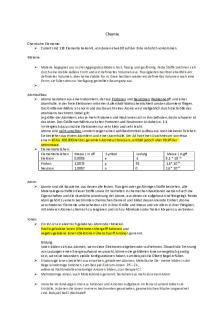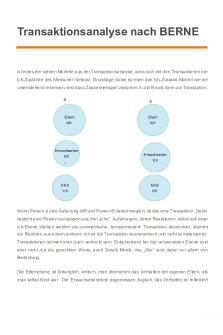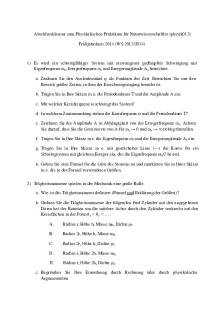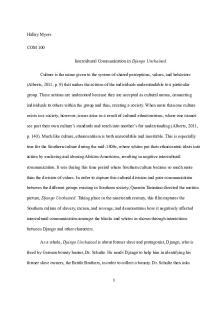Intercultural Relationships Essay Tasya Wise PDF

| Title | Intercultural Relationships Essay Tasya Wise |
|---|---|
| Author | Tasya Wise |
| Course | Elements of Intercultural Communication |
| Institution | Grand Canyon University |
| Pages | 5 |
| File Size | 89.7 KB |
| File Type | |
| Total Downloads | 106 |
| Total Views | 139 |
Summary
Download Intercultural Relationships Essay Tasya Wise PDF
Description
1
Tasya Wise COM-263 August 6, 2020, Professor Matthews Intercultural Relationships Everywhere around the globe is diverse and is full of many different cultures, beliefs, and values. These different cultures allow for different life experiences for all types of people which, allows intercultural relationships to form. Some of these relationships feature differences in age, gender, ethnicity, race, and religion. Intercultural relations have a balance of similarities and differences between different people's way of life (Campbell, Silva, & Wright, 2012). These relationships are beneficial because they allow people to communicate effectively with people from different cultures, gain knowledge, break stereotypes, and acquire new skills from different lifestyles (Campbell, Silva, & Wright, 2012). By looking inside intercultural relationships, one can see how cultural factors influence ethical relationships, different perspectives on developing, maintaining, or ending relationships, different cultural values and norms that influence conflict styles, and different conflict styles which, is essential because it allows for all cultures to be respected and acknowledged. Religion, language, verbal and nonverbal communication, experiences, and education are some factors that make up a person's culture (Kalyani, 2018). These factors also can influence a person's idea of what is ethical or not. Ethics is based on what is right and wrong, what is good or bad in human behavior depending on the person beliefs. Conducting business is an example of an action that is influenced by ethical standards. Language and communication influence ethical
2
relationships between cultures because one is influenced by their morals which, then turns into how one communicates with others. Religion, experiences, and education also affect ethical relationships because it teaches responsibility, service, and encourages helping others (Johannessen & Skeie, 2019). All of these factors make up how a person treats another person from a different culture through their ethical standards and reasoning. Developing, maintaining, or ending relationships between different cultural groups is a challenge because it attracts different perceptions and expectations. Communication is also how relationships are formed and finished. One perspective is interaction with people from different cultures or new people, in general, can be full of uncertainty and anxiety (Nauliep, 2018). Information like social background, how others behave socially, understand other's feelings, what it means to communicate, and if the proper dialogue is established are what people with highcontext culture look for when meeting new people. Another perspective is a low-context culture person asks a lot of questions, typically. Issues like language miscommunication or jealousy can cause bad communication, especially when two different types of cultures clash. Expressing feelings healthily and practicing appropriate language communication is often how most relationships are maintained. Proper education and respect of other cultures and traditions also make a huge difference in how culture shapes intercultural relationships. High and low context culture and communication allows for developing, maintaining, or ending relationships, but so does religion. I say this because it affects human perception and cultural relationship growth. The idea of diversity is at the center of fostering, sustaining, and ending relationships because religious issues allow people to consider one another viewpoint (Johannessen & Skeie, 2019). Multiculturalism is the support of serval different cultural and ethnic groups within a society which, allows people to establish cultural experiences and ties
3
(Johannessen & Skeie, 2019). Ultimately, people come from different walks of life but based on the cultural backgrounds a person holds that allows making cultural differences understandable and can achieve equal intercultural relationships. Different cultural values and norms influence the types of conflict resolution, which can be followed by people in conflict. The interaction and response showed by people when a dispute arises more than likely depends on a person's cultural values and tradition. Intercultural conflict is a type of conflict that happens when people from different cultures and backgrounds clash over cultural beliefs and values. When an intercultural conflict occurs, one's culture becomes a factor in how the conflict is perceived, managed, and resolved (Nauliep, 2018). Mitchell Hammer developed a model of intercultural conflict based on the inventory he created. Hammer's theory says people need to understand and recognize that there are differences in conflict styles in cultural communities. People need to understand and learn from each other on how to resolve intercultural conflicts (Nauliep, 2018). Based on culture, different conflict styles may be appropriate for the solution. The discussion style, this style, approaches a conflict head-on and emotionally restrained. This style is typical for America and many northern European countries (Kim & Meyers, 2012). The engagement style is direct communication and emotionally expressive. Spain, Greece and some other European countries prefer engagement. The accommodation style communicates indirectly and with no emotion. This style is very the norm for China, Japan, and elsewhere. Lastly, the dynamic form relates indirectly but is emotionally evocative, usually with anger or strong feelings (Nauliep, 2018). Many parts of the Middle East dynamic are the norm (Kim & Meyers, 2012). However, the most successful approach to conflict is to compromise. Methods
4
that allow the concern for the greater good to be put first is the most successful method in resolving intercultural conflict. Cultural differences affect how people from different cultures handle conflicts. Some examples of different conflict styles of people from different cultures are collaborating, avoiding, accommodating, and compromising (Kim & Meyers, 2012). The majority of studies have shown that Easterners are less confrontational, less assertive, and more cooperative than Westerns. The Chinese prefer less assertive strategies, such as compromising and avoiding behaviors, where British people use more direct styles like collaborating and competing methods (Kim & Meyers, 2012). Culture shapes the way conflict is name, blame, and tamed, and culture plays a central role. It is essential to understand all cultures to be respected and acknowledged. Ethical relationships, different perspectives on the ethics of developing, maintaining, or ending relationships, differing cultural values and norms, and different conflict styles of people from different cultures all allow for intercultural relations to form appropriately. Language strengthens intercultural relationships through verbal and nonverbal communication. Religion, experiences, and education make room for people from different cultures to accept those that are different. Culture and intercultural relationships are all about the world being a diverse place and allowing those who are different from being themselves without being judged.
5
References Campbell, K., Silva, L., & Wright, D. (2012). Intercultural Relationships: Entry, Adjustment, and Cultural Negotiations. Journal of Comparative Family Studies, 43(6), 857-870. Johannessen, Ø. L., & Skeie, G. (2019). The Relationship between Religious Education and Intercultural Education. Intercultural Education, 30(3), 260–274. Kalyani, A. (2018). What ways can culture affect ethical standards and shape business behavior? Retrieved from https://bizfluent.com/12083818/what-ways-can-culture-affect-ethicalstandards-shape-business-behavior Kim, J., & Meyers, R. (2012). Cultural Differences in Conflict Management Styles in East and West Organizations. Retrieved from https://www.immi.se/intercultural/nr29/kim.html Nauliep, J. W. (2018). Intercultural communication: A contextual approach (7th ed.). Thousand Oaks, CA: Sage Publications....
Similar Free PDFs

Comunicación intercultural
- 21 Pages

Negociacion Intercultural
- 19 Pages

Chemie - WiSe
- 10 Pages

Transaktionsanalyse - WiSe
- 2 Pages

Übungen - WiSe
- 55 Pages

Intercultural relationship paper
- 5 Pages

INTERCULTURAL COMMUNICATION in Contexts
- 560 Pages

Abschlussklausur WiSe 2014, Fragen
- 14 Pages
Popular Institutions
- Tinajero National High School - Annex
- Politeknik Caltex Riau
- Yokohama City University
- SGT University
- University of Al-Qadisiyah
- Divine Word College of Vigan
- Techniek College Rotterdam
- Universidade de Santiago
- Universiti Teknologi MARA Cawangan Johor Kampus Pasir Gudang
- Poltekkes Kemenkes Yogyakarta
- Baguio City National High School
- Colegio san marcos
- preparatoria uno
- Centro de Bachillerato Tecnológico Industrial y de Servicios No. 107
- Dalian Maritime University
- Quang Trung Secondary School
- Colegio Tecnológico en Informática
- Corporación Regional de Educación Superior
- Grupo CEDVA
- Dar Al Uloom University
- Centro de Estudios Preuniversitarios de la Universidad Nacional de Ingeniería
- 上智大学
- Aakash International School, Nuna Majara
- San Felipe Neri Catholic School
- Kang Chiao International School - New Taipei City
- Misamis Occidental National High School
- Institución Educativa Escuela Normal Juan Ladrilleros
- Kolehiyo ng Pantukan
- Batanes State College
- Instituto Continental
- Sekolah Menengah Kejuruan Kesehatan Kaltara (Tarakan)
- Colegio de La Inmaculada Concepcion - Cebu







